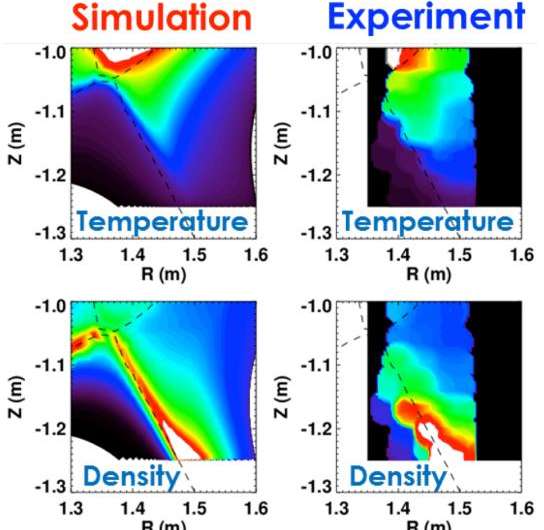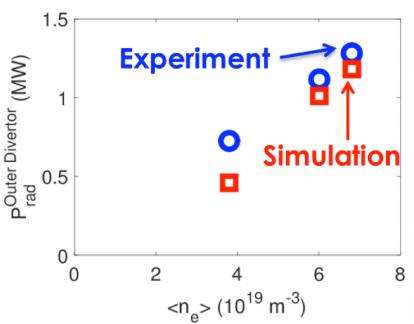Fixing deficits in boundary plasma models

Researchers working on the DIII-D tokamak in San Diego are working to show how plasma transport and atomic physics come together to provide power exhaust solutions.
One of the grand challenges facing fusion scientists is dealing with the massive power fluxes exhausted by fusion plasmas, which are created in devices called tokamaks like the DIII-D National Fusion Facility. Left to its own devices, the intense power carried in a tokamak plasma would be focused into such a small area that it would rapidly destroy any material in its way.
The standard strategy for handling the power exhaust in reactors is to convert the heat into electromagnetic radiation, which spreads the power more evenly and gives the metal walls surrounding the plasma a fighting chance. This process occurs in the tokamak's divertor, a device that serves as a buffer region between the fusing plasma and the surrounding chamber walls.
Until now, simulations have predicted far less radiation than is measured in experiments. This has been attributed to the highly complicated combination of atomic and molecular physics at play in the divertor region, which is challenging to fully include in simulations. Researchers at DIII-D have taken another approach to study the problem: eliminate the molecular physics from the experiment by running plasmas using Helium, a noble gas that does not form molecules (Figure 1).

These experiments have shown that the radiation can be fully reproduced in simulations, provided that the divertor plasma parameters are accurately accounted for (Figure 2). Doing this accounting relied on matching the density directly measured in the divertor—a measurement uniquely available at DIII-D. Using measurements in the more distant edge of the main plasma as input to the simulation, as is usually done, isn't good enough, bringing out that a link is missing in the plasma transport connecting the main plasma to the divertor. Once this is accounted for, the plasma within the divertor can also be reproduced using the models.
"These results give significantly more confidence in our ability to use simulations to design radiating exhaust solutions for the future, which is critical to the success of the fusion endeavor," said Dr. John Canik of Oak Ridge National Laboratory, which led the team that included scientists from Lawrence Livermore National Laboratory and General Atomics, which operates the DIII-D facility in cooperation with the U.S. Department of Energy.
This success also points to the importance of capturing the more complicated atomic and molecular physics of standard plasmas, explained Dr. Canik. The team's results will be reported at the 58th annual conference of the American Physical Society Division of Plasma Physics in San Jose
"This work has brought out a 'missing link' in the plasma transport connecting the divertor back up to the main plasma," he said, noting that their work will be the subject of future experiments.
More information: meetings.aps.org/Meeting/DPP16/Session/JI3.2
Provided by American Physical Society





















